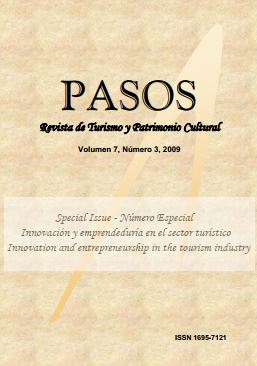El impacto del ferrocarril en la sociedad americana: una perspectiva de comunicación de la tecnología
DOI:
https://doi.org/10.25145/j.pasos.2009.07.032Palabras clave:
Comunicación, Ferrocarril, Sociedad, Tecnología, TiempoResumen
Este manuscrito examina el sistema ferroviario como una combinación de humanos y máqui- nas en relación simbiótica, y explica cómo el ferrocarril ejerció un importante efecto sobre la vida en América cuando hizo irrelevante el sistema de tiempo físico –natural—que existe en las ciudades y paí- ses en los que los relojes iban acordes a las condiciones climáticas. El autor apunta que el ferrocarril es un órgano social, capaz de evolucionar para servir a la demanda, modelando y alterando –pero nunca reemplazando—el contacto entre los humanos, y que continuará para mejorarlo y facilitarlo. Este ma- nuscrito analiza los impactos sociales, transculturales, psicológicos y financieros de la vía férrea en la sociedad norteamericana en los últimos doscientos años. La medida del progreso en los Estados Unidos es equivalente al conjunto de cosas que se han sacrificado.
Descargas
Datos de publicación
Perfil evaluadores/as N/D
Declaraciones de autoría
- Sociedad académica
- PASOS. Revista de Turismo y Patrimonio Cultural
- Editorial
- Instituto Universitario de Investigación Social y Turismo. Universidad de La Laguna (España) - Instituto Universitario da Maia ISMAI (Portugal)
Citas
Bartky, Ian. 1989 “The adoption of standard time.” Technology and Culture, 30: 25-56.
Blaise, Clark. 2001 Time lord: Sir Sandford Fleming and the creation of standard time. New York: Pantheon Books.
Burguess, Anthony. 1962 A clockwork orange. London: Heinemann.
Chandler Jr., Alfred. 1981 The railroads: the nation’s first big business. New York: Arno.
Comstock, Henry. 1971 The iron horse; America’s steam locomotives: a pictorial history. New York: Thomas Y.
Crowell. Cowan, Harrison. 1958 Time and its measurements. Cleveland, OH: World Publishing Company.
Drucker, Peter. 1999 “Beyond the information revolution.” The Atlantic Online, 284: 47-57.
Fernández-Armesto, Felipe. 1996 Millennium, a history of our last thousand years. London: Black Swan.
Fogel, Robert. 1964 Railroads and American economic growth: essays in econometric his- tory. Baltimore: Johns Hopkins UP.
Gordon, John Steele. 2001 “Standard time.” American Herit- age, 52: 22-24.
Hawking, Stephen. 1998 A brief history of time. New York: Bantam Doubleday Dell Pub.
Hindle, Brooke, and Steven Lubar. 1986 Engines of change: the American Industrial Revolution, 1790-1860. Washington: Smithsonian Institution.
Kasson, John. 1991 Rudeness and civility: manners in nineteenth-century urban America.
New York: The Noonday Press.
Kern, Stephen. 1986 The culture of time and space,1880-1918. Cambridge: Harvard UP. Langone, John. 2000 The mystery of time: humanity’s quest for order and measure. National Geographic.
Lewin, Kurt. 1951 Field theory in social science. New York: Harper.
Licht, Walter. 1995 Industrializing America: the nineteenth century. Baltimore: The Johns Hopkins UP.
Lyon, David. 1994 The electronic eye: the rise of surveillance society. Minneapolis: University of Minnesota Press.
MacKenzie John, and Jeffrey Richards. 1986 The railway station: a social history. Oxford: Oxford UP.
Matellart, Armand. 1974 Mapping world communication: war, progress, culture. Minneapolis: University of Minnesota Press.
Monsma, Stephen. 1986 Responsible technology. Grand Rapids, MI: William B. Eerdmans Publishing Company.
Morrisett, Lloyd. 1996 “Habits of mind and a new technology of freedom.” First Monday, 1:5-9.
Mumford, Lewis. 1934 Technics and civilization. New York: Harcourt Brace & Company. Nietzsche, Friedrich. 1967 The will to power. New York: Random House.
Norman, Donald.1993 Things that make us smart: defending human attributes in the age of the machine. Cambridge, MA: Perseus Books.
Paglia, Camille. 1998 “Rock around the clock.” Forbes, 162: 274-277.
Polli, Andrea. 1998 “The ‘Live Live!’ project: public art and technology.” Artists Using Science and Technology, 5: 12-19.
Poor, Henry. 1970 History of the railroads and canals of the United States of America: 1860. Baltimore: Johns Hopkins UP.
Pounds, Norman. 1985 An historical geography of Europe, 1800-1914. Cambridge: Cambridge UP.
Priestley, John. 1964 Man and time. Garden City, NY: Doubleday.
Rothstein, Edward. 1999 Looking at the transcontinental railroad as the internet of 1869. New York Times, 15668, p. A1.
Sproull, Lee, and Sara Kiesler. 1991 Connections: new ways of working in the networked organization. Cambridge, MA: Massachusetts Institute of Technology P.
Turnock, David. 1998 Historical geography of railways in Great Britain and Ireland. Ashgate, VT: Brookfield.
Virilio, Paul. 1986 Speed and politics. New York: Semiotext(e).
Webb, Michael. 1993 Sandford Fleming: railway builder. Toronto: Copp Clark Pitman. Weitzman, David. 1987 Superpower: the making of a steam locomotive. Boston: David R. Godine.
White, John. 1968 American locomotives: an engineer- ing history, 1830-1850. Baltimore: Johns Hopkins Press.
Zillmannn, Dolf, and Peter Vorderer. 2000 Media entertainment: the psychology of its appeal. Mahwah, NJ: Erlbaum.
Schivelbusch, Wolfgang. 1987 The railway journey: the industrialization of time and space in the 19th century. San Francisco: University of California Press
Descargas
Publicado
Cómo citar
Número
Sección
Licencia
Confirmo que el trabajo es original (de mi/nuestra autoría), y que no se someterá a otras revistas o publicaciones hasta la resolución definitiva del proceso de revisión en PASOS, RTPC.
Autorizo la publicación de mi trabajo por PASOS, RTPC de acceso abierto y gratuito en cualquiera de los formatos que estime oportunos, por un plazo indeterminado y a título de colaboración no remunerada.
Asimismo, el/los autor/es entiende/n que el trabajo publicado podrá vincularse o depositarse en cualquier servidor o ser incluido en otras publicaciones (republicación), siempre y cuando el nuevo lugar y/o la nueva edición referencie la publicación original y reconozca la autoría y la propiedad del copyright de las publicaciones de PASOS RTPC.
Los/as autores/as entienden que se realizará una comprobación de plagio-autoplagio, pudiendo retirarse el artículo en cualquier momento del flujo editorial










